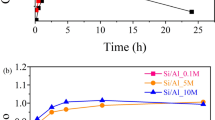Abstract
This paper describes recent experimental results concerning investigation of the parameters which determine, on the one hand, the kinetics of hydration of tricalcium silicate and the thermodynamic, morphological and structural characteristics of C-S-H and, on the other hand, the evolution of the particle interactions at the origin of setting. It is shown that, in both cases, lime concentration in solution is the most important parameter. As a consequence, the chemical evolution of the system, which controls the lime concentration in solution, determines the nature of particle interactions and the physical evolution of the suspension or paste. In return, the contacts, between particles, resulting from the coagulation of the suspension, seem to have a role in the kinetics of the chemical reaction.
Resume
Cet article décrit les résultats expérimentaux récents concernant la recherche des paramètres déterminant, d'une part, la cinétique d'hydration du silicate tricalcique et les caractéristiques thermodynamiques, morphologiques et structurales du C-S-H produit, et d'autre part, l'évolution des interactions interparticuliéres à l'origine de la prise. On montre que, dans tous les cas, c'est la concentration en ions calcium en solution (ou en équivalent hydroxyde de calcium) qui est le paramètre déterminant. De ce fait, l'évolution chimique du système, qui fixe la concentration en calcium en solution, détermine la nature des interactions particulières et l'évolution physique de la suspension ou de la pâte. En retour, le nombre de contacts entre les particules résultant de la coagulation de la suspension, apparaissent avoir un rôle sur la cinétique de la réaction chimique. Cet article est une adaption de la conférence présentée à l'occasion de la remise de la Médaille Robert L'Hermite, lors de la 47ème Réunion du Conseil Général de la RILEM à Haifa, le13 Octobre1933.
Similar content being viewed by others
References
Garboczi, E. J., ‘Computational materials science of cement-based materials’,Mater. Struct.,26 (1993) 191–195.
Damidot, D., Nonat, A. and Barret, P. ‘Kinetics of tricalcium silicate hydration in diluted suspension by microcalorimetric measurements’,J. Am. Ceram. Soc.,73 (11) (1990) 3319–22.
Damidot, D. and Nonat, A., ‘A method for determining the advancement of the hydration of C3S in diluted suspensions by means of simultaneous conductimetric and calorimetric measurements’, in Proceedings of 9th International Congress on the Chemistry of Cement, New Delhi, 1992, Vol. III, pp. 227–236.
Nonat, A. and Mutin, J. C., ‘From hydration to setting’, in ‘Hydration and Setting of Cement’, pp. 171–191, edited by A. Nonat and J. C. Mutin (E&F Spon, London, 1992).
Jiang, S. P., Mutin, J. C. and Nonat, A., ‘Analysis of the hydration-setting relation: towards, a phenomenological approach of cement setting’, in Proceedings of 9th International Congress on the Chemistry of Cement, New Delhi, 1992, Vol. III, pp. 17–23.
Damidot, D. and Nonat, A., ‘C3S Hydration in diluted and stirred suspension: I. Evidence of two C-S-H precipitation steps’,Adv. Cement Res., in press.
Damidot, D. and Nonat, A., ‘C3H Hydration in diluted and stirred suspension: II. Properties of the two C-S-H precipitation steps’,Adv. Cement Res., in press.
Barret, P. and Bertrandie, D., “Fundamental hydration kinetic features of the major cement constituents’,J. Chim. Phys. (1986) 765–775.
Lecoq, X., Thesis, University of Bourgogne, Dijon, 1993.
Damidot, D. and Nonat, A., Investigations on C3S Hydration process during the first hours’, in ‘Hydration and Setting of Cements’, edited by A. Nonat and J. C. Mutin, pp. 23–34 (E&F Spon, London, 1992).
Damidot, D. and Nonat, A., ‘C3S Hydration in diluted and stirred suspension: III. NMR study of the two C-S-H precipitation steps’,Adv. Cement Res., in press.
Taylor, H. F. W., ‘Proposed structure for calcium silicate hydrate gel’,J. Am. Ceram. Soc.,69(6) (1986) 464–467.
Delville, A., ‘Molecular and electrostatic forces in the stability of charged surfaces’, in ‘Hydration and Setting of Cements’, edited by A. Nonat and J. C. Mutin, pp. 253–264 (E&F Spon, London, 1992).
Jiang, S. P., Mutin, J. C. and Nonat, A., ‘Effect of melment superplasticizer on C3S hydration: from suspension to paste’, in Proceedings of the 3rd Beijing International Symposium on Cement and Concrete, 1993, pp. 126–131 (China Building Materials Academy, 1993).
Jiang, S. P., Mutin, J. C. and Nonat, A., ‘Effect of fillers on the kinetics of cement hydration’, in Proceedings of the 3rd Beijing International Symposium on Cement and Concrete, 1993, pp. 132–137 (China Building Materials Academy, 1993).
Author information
Authors and Affiliations
Additional information
This paper is an adaptation, of the conference presentation by author when he was awarded the Robert L'Hermite Medal during the 47th meeting of the RILEM General Council in Haifa on 13 October 1993.
Rights and permissions
About this article
Cite this article
Nonat, A. Interactions between chemical evolution (hydration) and physical evolution (setting) in the case of tricalcium silicate. Materials and Structures 27, 187–195 (1994). https://doi.org/10.1007/BF02473032
Issue Date:
DOI: https://doi.org/10.1007/BF02473032




